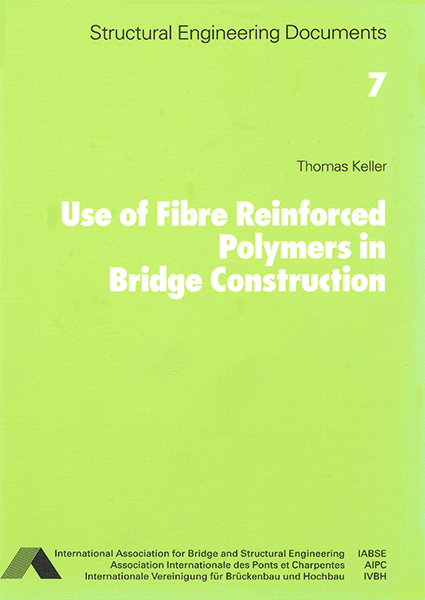Use of fibre reinforced polymers in bridge construction

|
|
|||||||||||
Détails bibliographiques
| Auteur(s): |
Thomas Keller
|
||||
|---|---|---|---|---|---|
| Médium: | livre | ||||
| Langue(s): | anglais | ||||
| Editeur: | International Association for Bridge and Structural Engineering (IABSE) | ||||
| Publié à: | Zurich, Suisse | ||||
|
|||||
| Page(s): | 131 | ||||
| Nombre total de pages (du PDF): | 140 | ||||
| Année: | 2003 | ||||
| ISBN-10: | 3-85748-108-0 | ||||
| ISBN-13: | 978-3-85748-108-6 | ||||
| DOI: | 10.2749/sed007 | ||||
| Collection: | Structural Engineering Documents (No. 7) | ||||
| Couverture: | broché | ||||
| Remarques: |
The aim of the present Structural Engineering Document, a state-of-the-art report, is to review the progress made worldwide in the use of fibre reinforced polymers as structural components in bridges until the end of the year 2000. Due to their advantageous material properties such as high specific strength, a large tolerance for frost and de-icing salts and, furthermore, short installation times with minimum traffic interference, fibre reinforced polymers have matured to become valuable alternative building materials for bridge structures. Today, fibre reinforced polymers are manufactured industrially to semi-finished products and ccimplete structural components, which can be easily and quickly installed or erected on site. Examples of semi-finished products and structural components available are flexible tension elements, profiles stiff in bending and sandwich panels. As tension elements, especially for the purpose of strengthening, strips and sheets are available, as weil as reinforcing bars for concrete reinforcement and prestressing members for internal prestressing or external use. Profiles are available for beams and columns, and sandwich constructions especially for bridge decks. During the manufacture of the structural components fibre-optic sensors for continuous monitoring can be integrated in the materials. Adhesives are being used more and more for joining components. Fibre reinforced polymers have been used in bridge construction since the mid-1980s, mostly for the strengthening of existing structures, and increasingly since the mid-1990s as pilot projects for new structures. In the case of new structures, three basic types of applications can be distinguished: concrete reinforcement, new hybrid structures in combination with traditional construction materials, and all-composite applications, in which the new materials are used exclusively. This Structural Engineering Document also includes application and research recommendations with particular reference to Switzerland. This book is aimed at both students and practising engineers, working in the field of fibre reinforced polymers, bridge design, construction, repair and strengthening. |
||||
| Mots-clé: |
construction de ponts
|
||||
| Acheter chez: | |||||
| Copyright: | © International Association for Bridge and Structural Engineering | ||||
| License: | Cette oeuvre ne peut être utilisée sans la permission de l'auteur ou détenteur des droits. |
||||
